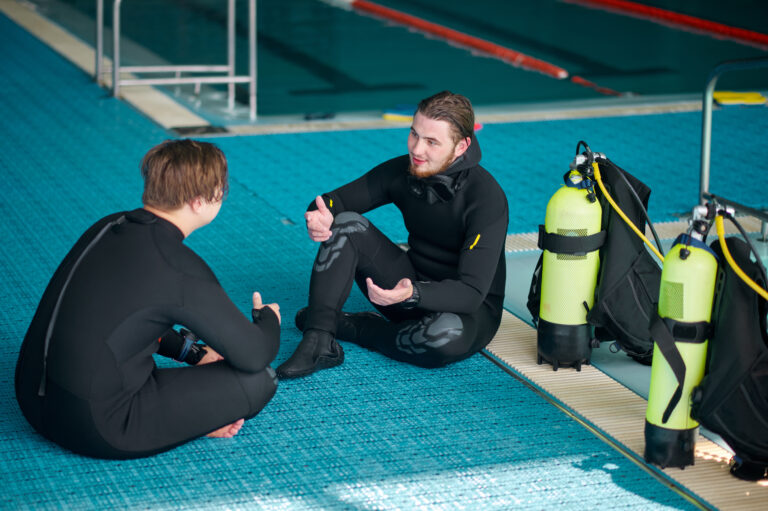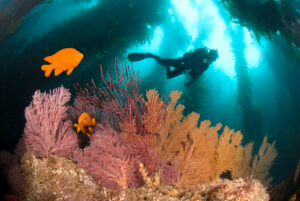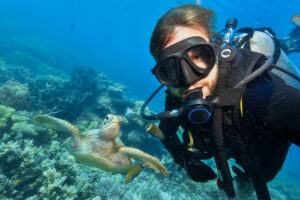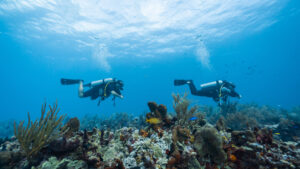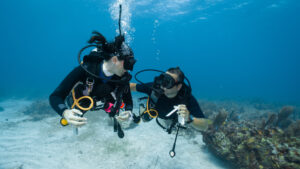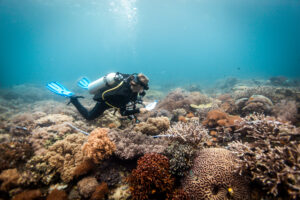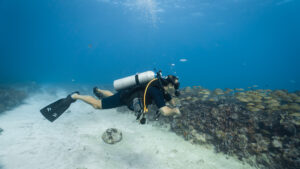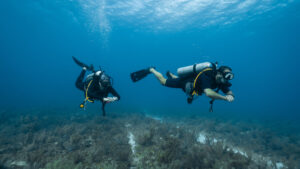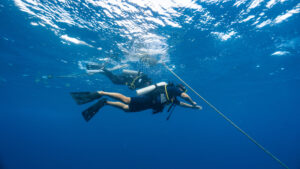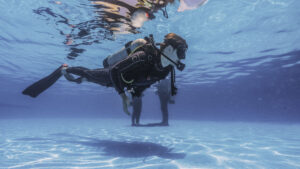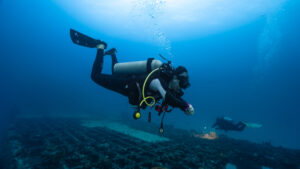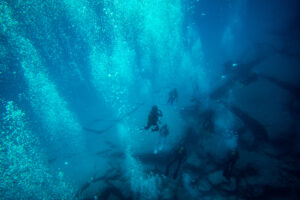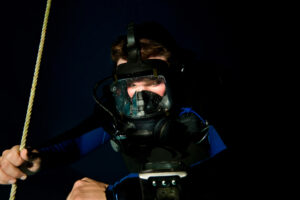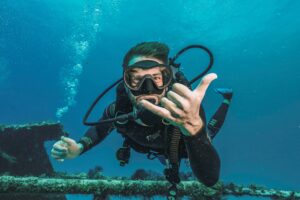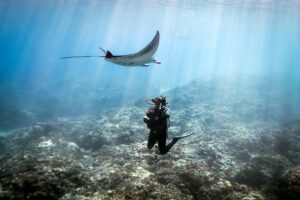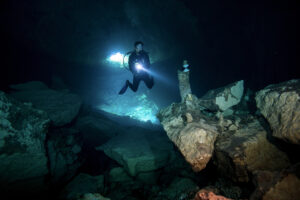What is Oxygen?
Oxygen is a fundamental element essential for the survival of almost all living organisms. In the context of scuba diving, understanding oxygen’s properties and its role is crucial for both safety and performance. This article delves into the various aspects of oxygen, from its basic chemistry to its physiological effects on divers, and the technologies used to manage it underwater. As one of the critical components in breathing gas mixtures, oxygen’s management and the equipment designed for its delivery are vital for successful and safe scuba diving experiences.
Basic Chemistry and Role of Oxygen
Oxygen, represented by the symbol O and atomic number 8, is a chemical element known for its reactivity and vital role in supporting life. It is a diatomic molecule (O2) in its most stable and abundant form, making up about 21% of Earth’s atmosphere. This element is essential for cellular respiration, the process by which cells produce energy. In this process, oxygen reacts with glucose to produce carbon dioxide, water, and ATP (adenosine triphosphate), the energy currency of cells. This energy production is critical for the functioning of organs and tissues in the human body.
The role of oxygen extends beyond mere respiration. It is a key player in the metabolic processes that keep organisms alive and thriving. In the human body, oxygen is transported via the bloodstream, bound to hemoglobin in red blood cells. This transport system ensures that oxygen reaches all parts of the body, facilitating aerobic respiration and energy production. Without sufficient oxygen, cells switch to anaerobic respiration, which is less efficient and produces lactic acid, leading to muscle fatigue and other issues.
In scuba diving, oxygen’s role is both beneficial and potentially hazardous. While it is necessary for life, high concentrations or improper use can lead to oxygen toxicity, a serious condition that can affect divers. This dual nature of oxygen requires careful management and understanding, making it a central focus in diving training and equipment design.
Oxygen in the Earth’s Atmosphere
The Earth’s atmosphere is composed of roughly 78% nitrogen, 21% oxygen, and traces of other gases. This stable composition provides the necessary conditions for life as we know it. Oxygen’s presence in the atmosphere is a result of photosynthesis, a process carried out by plants, algae, and certain bacteria. Through photosynthesis, these organisms convert carbon dioxide and water into glucose and oxygen, releasing oxygen into the atmosphere as a byproduct.
For scuba divers, understanding the composition of the Earth’s atmosphere is essential. The air we breathe on the surface is different from the air we use underwater. At sea level, the partial pressure of oxygen is adequate to meet the body’s needs without causing toxicity. However, as divers descend, the pressure increases, affecting the behavior of gases. This increase in pressure means that the partial pressure of oxygen also rises, which can have significant implications for breathing and safety underwater.
The relationship between atmospheric oxygen and diving becomes more complex when considering the various breathing gas mixtures used. Standard air, which contains 21% oxygen, is suitable for most recreational dives. However, for deeper or technical dives, mixtures like Nitrox (enriched air with higher oxygen content) or Trimix (a blend of oxygen, nitrogen, and helium) are used. These mixtures help manage the partial pressures of oxygen and other gases, ensuring safe and efficient breathing at different depths.
Oxygen in the Aquatic Environment
Oxygen is not only crucial in the atmosphere but also plays a significant role in aquatic environments. Dissolved oxygen in water is vital for the survival of marine life. The solubility of oxygen in water depends on various factors, including temperature, salinity, and pressure. Cold water holds more dissolved oxygen than warm water, and fresh water holds more oxygen than salt water. These variations can affect the types of organisms found in different aquatic environments and their behaviors.
For scuba divers, understanding oxygen solubility in water is important, particularly when diving in different environments. In colder waters, higher levels of dissolved oxygen can support more abundant and diverse marine life, making these areas popular for diving. Conversely, warmer waters with lower dissolved oxygen levels might require different diving strategies and considerations, especially for maintaining buoyancy and managing breathing gas supplies.
Marine organisms have adapted to varying levels of dissolved oxygen in their environments. Fish, for example, use gills to extract oxygen from water, while other organisms, like certain bacteria, can survive in low-oxygen or even anaerobic conditions. These adaptations influence the distribution and behavior of marine life, which divers must consider when planning their underwater activities. Understanding these dynamics helps divers appreciate the delicate balance of aquatic ecosystems and the importance of preserving them.
Oxygen Equipment and Technologies in Scuba Diving
Scuba diving relies heavily on advanced equipment and technologies designed to deliver oxygen safely and effectively. The most critical piece of equipment is the scuba tank, which stores compressed breathing gas. These tanks are typically made from aluminum or steel and come in various sizes, depending on the dive’s depth and duration. The standard scuba tank contains compressed air, but for specific dives, tanks may be filled with Nitrox, Trimix, or pure oxygen.
The regulator is another essential component of scuba gear. It reduces the high-pressure gas from the tank to a breathable pressure and delivers it to the diver through a mouthpiece. Modern regulators are designed with multiple stages to ensure smooth and reliable gas flow. Some advanced regulators also feature adjustable settings to optimize performance at different depths and under various conditions.
Rebreathers represent a significant advancement in scuba technology. Unlike traditional open-circuit scuba systems, rebreathers recycle the diver’s exhaled gas, removing carbon dioxide and replenishing oxygen. This system allows for longer dives with less gas consumption and reduced bubble emissions, which can be advantageous for underwater photographers and researchers. Rebreathers are complex devices requiring specialized training, but they offer significant benefits for technical and deep-sea diving.
Safety mechanisms are integral to all scuba diving equipment. Pressure gauges, dive computers, and emergency oxygen kits are standard tools that help divers monitor and manage their oxygen levels. These devices provide real-time data on depth, dive time, and remaining gas supply, enabling divers to make informed decisions and avoid potential hazards. Emergency oxygen kits are particularly crucial in managing cases of decompression sickness and other diving-related injuries, underscoring the importance of proper oxygen management.
Physiological Effects of Oxygen on Divers
The physiological effects of oxygen on divers are profound and multifaceted. At sea level, the partial pressure of oxygen is about 0.21 atmospheres, which is sufficient to sustain normal bodily functions. However, as divers descend, the pressure increases, and the partial pressure of oxygen rises accordingly. This increase can lead to oxygen toxicity, a condition where high concentrations of oxygen become harmful to the body.
Oxygen toxicity primarily affects the central nervous system and the lungs. Symptoms of central nervous system oxygen toxicity include visual disturbances, ringing in the ears, nausea, twitching, irritability, and, in severe cases, seizures. Pulmonary oxygen toxicity, on the other hand, results from prolonged exposure to elevated oxygen levels and can cause symptoms such as coughing, chest pain, and difficulty breathing. To mitigate these risks, divers must carefully monitor their oxygen exposure and adhere to recommended depth and time limits.
Maintaining a balance of oxygen levels in breathing mixtures is crucial to avoid hypoxia (insufficient oxygen) and hyperoxia (excess oxygen). Hypoxia can occur if the oxygen concentration in the breathing gas is too low, leading to impaired judgment, loss of consciousness, and, if not addressed promptly, death. Hyperoxia, resulting from high oxygen concentrations, can cause the aforementioned toxicity issues. Divers use specialized gas mixtures and follow strict dive profiles to manage these risks effectively.
The long-term effects of oxygen exposure at various pressures are still a subject of ongoing research. While short-term dives with controlled oxygen levels are generally safe, repeated or prolonged exposure can have cumulative effects. These may include oxidative stress, which can damage cells and tissues over time. Understanding these long-term effects is essential for developing guidelines and best practices to ensure the health and safety of divers, particularly those engaged in professional or technical diving.
Oxygen Management in Scuba Diving
Effective oxygen management is a cornerstone of safe scuba diving. Divers must plan their dives meticulously, considering factors such as depth, duration, and the type of breathing gas used. For recreational dives, standard air with 21% oxygen is typically sufficient. However, for deeper or longer dives, enriched air mixtures like Nitrox, which contain higher oxygen levels, are preferred. Nitrox reduces the amount of nitrogen absorbed by the body, lowering the risk of decompression sickness.
Technical and deep-sea diving often requires more sophisticated gas mixtures, such as Trimix, which includes oxygen, nitrogen, and helium. Helium is used to replace some of the nitrogen, reducing the narcotic effects of nitrogen at depth and mitigating the risks of oxygen toxicity. The selection of an appropriate gas mixture depends on the dive profile and the specific requirements of the dive.
Training is crucial for effective oxygen management. Divers must be proficient in using their equipment, understanding gas mixtures, and recognizing the signs of oxygen toxicity and other related conditions. Advanced training courses, such as those for Nitrox and technical diving, provide the necessary knowledge and skills to manage oxygen safely. Emergency procedures, including the use of emergency oxygen kits and decompression protocols, are also essential components of dive training.
Dive planning software and dive computers have revolutionized oxygen management. These tools allow divers to input their dive profiles and receive real-time data and alerts, helping them stay within safe limits. Dive computers track depth, time, and gas consumption, providing critical information that enables divers to adjust their plans as needed. This technology has significantly enhanced the safety and efficiency of diving operations.
Key Takeaways
Oxygen is a vital element in scuba diving, playing a crucial role in breathing gas mixtures, physiological effects, and safety management. Understanding its basic chemistry, atmospheric presence, and behavior in water helps divers appreciate its importance. Advanced equipment and technologies, coupled with proper training and planning, ensure effective oxygen management and safe diving practices. Maintaining a balance of oxygen levels is essential to avoid both hypoxia and oxygen toxicity, making knowledge and vigilance key components of successful scuba diving.

